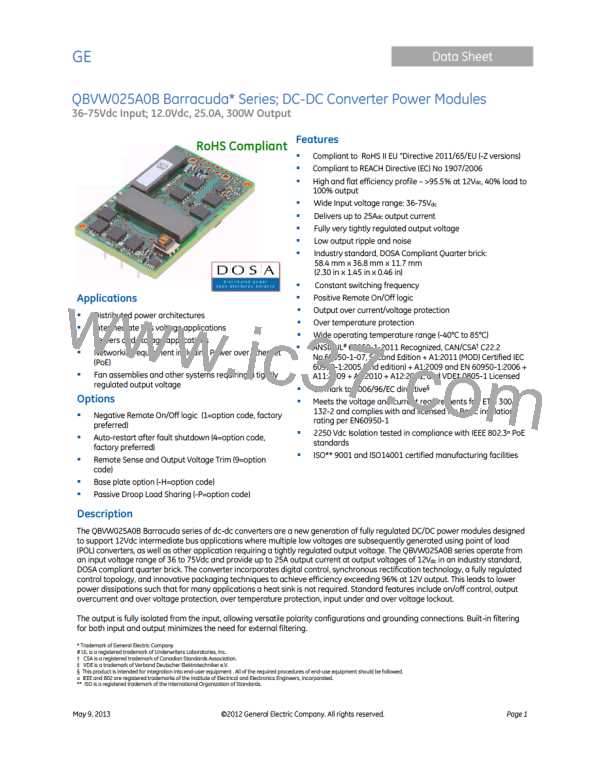Data Sheet
GE
QBVW025A0B Barracuda™ Series; DC-DC Converter Power Modules
36-75Vdc Input; 12.0Vdc, 25.0A, 300W Output
Feature Descriptions (continued)
Thermal Considerations
The thermal data presented here is based on physical
measurements taken in a wind tunnel, using automated
thermo-couple instrumentation to monitor key component
temperatures: FETs, diodes, control ICs, magnetic cores,
ceramic capacitors, opto-isolators, and module pwb
conductors, while controlling the ambient airflow rate and
temperature. For a given airflow and ambient temperature, the
module output power is increased, until one (or more) of the
components reaches its maximum derated operating
temperature, as defined in IPC-9592B. This procedure is then
.
repeated for a different airflow or ambient temperature until a
family of module output derating curves is obtained.
Figure 17. Location of the thermal reference temperature TH.
Figure 18. Location of the thermal reference temperature
TH3 for Base plate module.
The output power of the module should not exceed the rated
power for the module as listed in the Ordering Information
table.
Please refer to the Application Note “Thermal Characterization
Process For Open-Frame Board-Mounted Power Modules” for a
detailed discussion of thermal aspects including maximum
device temperatures.
The power modules operate in a variety of thermal
environments and sufficient cooling should be provided to help
ensure reliable operation.
Thermal considerations include ambient temperature, airflow,
module power dissipation, and the need for increased
reliability. A reduction in the operating temperature of the
module will result in an increase in reliability.
Heat Transfer via Convection
Increased airflow over the module enhances the heat transfer
via convection. The thermal derating of figure 19- 23 shows
the maximum output current that can be delivered by each
module in the indicated orientation without exceeding the
maximum THx temperature versus local ambient temperature
(TA) for air flows of, Natural Convection, 1 m/s (200 ft./min), 2
m/s (400 ft./min).
Heat-dissipating components are mounted on the top side of
the module. Heat is removed by conduction, convection and
radiation to the surrounding environment. Proper cooling can
be verified by measuring the thermal reference temperature
(TH1 or TH2). Peak temperature occurs at the position indicated
in Figure 17 and 18. For reliable operation this temperature
should not exceed TH1=125°C or TH2=105°C. For extremely high
reliability you can limit this temperature to a lower value.
The use of Figure 19 is shown in the following example:
Example
What is the minimum airflow necessary for a QBVW025A0B
operating at VI = 48 V, an output current of 20A, and a
maximum ambient temperature of 70 °C in transverse
orientation.
Solution:
Given: Vin= 48V, IO = 20A, TA = 60 °C
Determine required airflow (V) (Use Figure 19:
V = 0.5m/s (100 LFM) or gre
May 9, 2013
©2012 General Electric Company. All rights reserved.
Page 10

 LINEAGEPOWER [ LINEAGE POWER CORPORATION ]
LINEAGEPOWER [ LINEAGE POWER CORPORATION ]